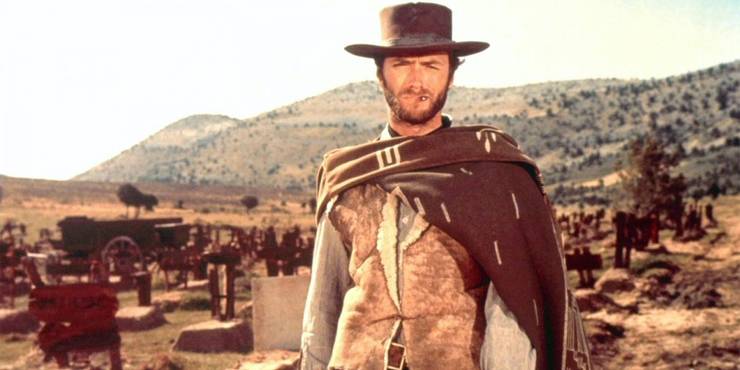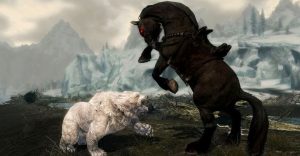Quentin Tarantino’s Favorite Spaghetti Westerns

Acclaimed and controversial director Quentin Tarantino has named his favorite movies in the spaghetti western genre, a type of movie he has repeatedly been inspired by. Tarantino provided a list of twenty films to the Spaghetti Western Database website while shooting Inglorious Basterds. The list provides both a great guide to the spaghetti western genre as well as insight into what qualities one of America’s most iconic modern directors looks for in movies.
The spaghetti western genre emerged in the 1960s in Italy, with directors and actors imitating the American western genre. The movies were mostly made on low budgets with casts and financing from a variety of European countries. As such, cast members often spoke their native language while shooting and were dubbed into whatever the language of release was, meaning that unlike other dubbed titles like Squid Game, there was no “true” audio track. Spaghetti westerns developed a cult following around the world for the unique, often intentionally revisionist, approach they took towards the familiar western genre.
Quentin Tarantino’s work has always been inspired by low-budget cinematic oddities, from B-movies on down, as well as international genre cinema. Spaghetti westerns fit into both categories, and have been referenced or imitated in Tarantino movies ranging from Django Unchained to Once Upon A Time in Hollywood. Tarantino is known for his encyclopedic film knowledge, and his extensive selection of spaghetti westerns demonstrates this.
20. Machine Gun Killers

This 1968 movie, directed by Paolo Bianchini, was also released under the titles Gatling Gun and That Damned Hot Day of Fire. The story sees Captain Chris Tanner, played by Robert Woods, trying to recover a stolen Gatling Gun from the Confederate army. The protagonist, an accused murderer, shows spaghetti Westerns’ interest in the antiheroes now popular in superhero films.
19. Viva Django

Viva Django is one of several movies on the list that stars a conflicted hero named Django, a kind of commonplace figure within spaghetti Westerns that Tarantino himself used in Django Unchained. In this movie, Django collects a gang of outlaws to go after a politician who ordered the killing of his wife. Terence Hill stars as Django, while Ferdinando Baldi directs.
18. The Ugly Ones

Based on a novel by Marvin Albert, The Ugly Ones involves a bounty hunter tracking down a bandit who is beloved by his local community. The storyline suggests the complicated morality and nuance that often appeared in spaghetti Western plots. The movie stars Richard Wyler, Thomas Milan, and Ella Karin.
17. Tepepa

Tepepa is set during the Mexican revolution, with the title character a wanted political leader. Co-starring is Citizen Kane star Orson Welles as an English doctor with a personal reason for vengeance. Welles’ role is an example of how many veteran actors, particularly those based in Europe, made surprising appearances in spaghetti Westerns.
16. Shoot The Living, Pray for the Dead

One of the most colorful movie titles you’ll find, Shoot the Living, Pray for the Dead is a fairly late spaghetti western, released in 1971. The film combines the western genre with the mystery thriller as a group of bandits look to escape to Mexico with stolen gold. The starring role is played by Klaus Kinski, a German actor who appeared in numerous spaghetti westerns but is today best known for his collaborations with eccentric filmmaker Werner Herzog.
15. The Grand Duel

The Grand Duel features Lee van Cleef, an iconic figure associated with the spaghetti Western genre. The movie, directed by Giancarlo Santi, builds up to a climactic battle between van Cleef’s Sheriff Clayton and Horst Frank’s David Saxon. Tarantino used The Grand Duel‘s theme song as part of the soundtrack for Kill Bill.
14. The Great Silence

The Great Silence is one of the few spaghetti westerns set in the snow, filmed in Veneto and South Tyrol. The film is one of the most acclaimed in the genre for its political commentary, and was recently restored and re-released on Blu-Ray. It is the first of four films on Tarantino’s list from director Sergio Corbucci, who Tarantino referenced as the director of two of the movies in the fictional career of Once Upon A Time in Hollywood‘s Rick Dalton.
13. The Dirty Outlaws

This spaghetti western involves an outlaw disguising himself as a Civil War soldier to steal a cache of gold. A gang of outlaws arriving complicates his scheme. The Dirty Outlaws is the only spaghetti western directed by Franco Rosetti, who wrote the screenplays for influential films like Django.
12. A Pistol for Ringo

A Pistol for Ringo was one of the most commercially successful spaghetti Westerns, building on the popularity of A Fistful of Dollars. The movie has a more lighthearted approach and a more straightforward hero than many of its contemporaries, with the baby-faced Ringo saving a town from bandits. It was scored by the legendary Ennio Morricone, who is associated with the spaghetti western genre but also composed music for several Hollywood movies, including The Thing and Tarantino’s The Hateful Eight.
11. The Big Gundown

Another excellently-titled movie, The Big Gundown features Lee van Cleef as bounty hunter Corbett hired to track down a fugitive. As the mission goes on, Corbett begins to doubt his employer’s motives. The Big Gundown also features a Morricone score and helped to establish van Cleef as a premier antihero.
10. The Return of Ringo

The Return of Ringo is a direct sequel to the aforementioned A Pistol for Ringo, bringing back director Duccio Tessari and star Giuliano Gemma who, like many spaghetti western stars, used an English-sounding screen name — in this case Montgomery Wood. The plot is loosely based on Homer’s Odyssey and sees Ringo returning home from the Civil War to find his hometown besieged by bandits. This puts it in a long line of strange adaptations of the classic story, alongside everything from the Coen brothers’ O Brother, Where Art Thou to James Joyce’s novel Ulysses.
9. Navajo Joe

Corbucci’s first movie with a Morricone score, Navajo Joe stars a young Burt Reynolds as the title character. It is one of the few westerns of any kind to feature an Indigenous protagonist, although perhaps not a sensitively-portrayed one. Navajo Joe is often praised for its bloody action and fast-paced revenge plot.
8. Death Rides a Horse

Another Lee van Cleef vehicle, Death Rides a Horse sees van Cleef as an outlaw seeking revenge on the gang that double-crossed him. He eventually teams up with John Phillip Law, played by Bill Meceita, who has a lifelong grudge against the gang. The movie was released in the US in 1969 at the height of spaghetti westerns’ popularity by MGM, then a major studio.
7. Day of Anger

Day of Anger brings together van Cleef and Giuliano Gemma, star of the Ringo movies. In the story, Gemma is the apprentice of a sheriff that van Cleef murders, setting the two on a collision course. This is the highest-ranked movie on Tarantino’s list that wasn’t directed by Sergio Leone or Corbucci, being helmed by Leone’s former assistant Tonino Valerii.
6. A Fistful of Dollars

A Fistful of Dollars is the first entry in Sergio Leone’s Man with No Name trilogy. Released in 1964, it helped to establish the spaghetti western genre and set the stage for some of the decade’s greatest films. Clint Eastwood’s amoral, violent protagonist was a shock compared to more traditional Western heroes and helped to establish Eastwood’s reputation as an icon.
5. Once Upon A Time in the West

On the other hand, Once Upon A Time in the West is commonly seen as Leone’s last great Western. The movie is a long, elegiac saga about a battle over land on the American frontier. The movie stars Claudia Cardinale, Henry Fonda in a rare performance as a villain, Jason Robards, and Charles Bronson as a mysterious gunman only known as Harmonica. Along with Leone’s gangster film Once Upon A Time in America, the film helped to establish the “Once Upon A Time in…” naming convention that has been used by filmmakers like Robert Rodriguez, Nuri Bilge Ceylan, and of course the famously referential Tarantino with Once Upon A Time in Hollywood.
4. The Mercenary

The Mercenary is a Corbucci western set during the Mexican Civil War. Franco Nero stars as a Polish mercenary who is motivated to join the struggle, another example of the frequently revolutionary subtext of Corbucci’s movies. The movie might be most notorious for Jack Palance’s turn as the sadistic villain Curly.
3. Django

The 1966 Django was Sergio Corbucci’s most famous film and spawned many imitators. Franco Nero starred as the eponymous antihero, who faced off against the KKK and gold-hungry bandits but kept his own motivations a mystery. Tarantino was one of many who used the name “Django” in his own Corbucci-inspired western Django Unchained.
2. For A Few Dollars More

The second movie in Leone’s Man With No Name trilogy, For A Few Dollars More pairs Eastwood’s nameless drifter with established star Lee van Cleef in a kind of western passing of the torch. The two team up to infiltrate the gang of the bank robber Indio. The movie was known for its use of flashbacks and moral ambiguity, and represented the broadening of Leone’s cinematic ambitions that would fully flower in his next film.
1. The Good, The Bad, and The Ugly

Tarantino’s #1 selection is one generally in line with critical consensus, establishing The Good, The Bad, and The Ugly as the greatest of all spaghetti Western films. The final installment in the Man with No Name Trilogy brings back van Cleef and Clint Eastwood’s gunslinger and introduces Eli Wallach as the scheming bandit Tuco, the trilogy that make up the movie’s title. The Good, The Bad, and The Ugly uses cinematic technique to create a heightened reality and is known for its dramatic set pieces and beautiful landscape shots.
Along with the top 20 list, Tarantino provided over a dozen runners up, including titles like If You Meet Sartana, Pray for your Death, God forgives, I don’t and They Call Me Trinity. It’s clear that Tarantino has a deep affection for the genre and that it has been a major influence on his career, especially his more recent titles which directly play with the iconography of the western.
About The Author

















